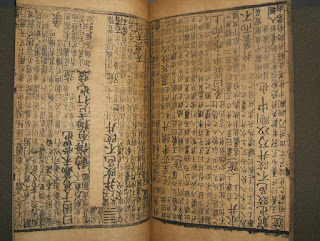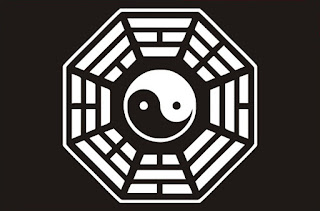In Chinese royal ancestral religion of the Shang and early Chou ( between the sixteenth and eight centuries BC ) was magic very important. Chinese sorcerer - The wu - effected medical plants cures and spells by sacrificing and invoking the spirits. Individuals known as fangshi ( ´person of techniques´) involved with wu tradition were outsiders, marginal or peripheral from the point of view of official Confucianist doctrine. These solitary seekers of the laws behind natural phenomena were specialized in astrology, medicine, geomancy and methods for achieving long life.
 |
| Modern Chinese shaman |
Some rulers favored shamans and established shamanic cults. Court was a place for all of those who claimed to possess magical powers and secrets of immortality. Such a ruler was Liu Chíe ( 140 - 87 BC) Conductor of souls to the place of dead - Li Shao-weng - gained favor from Liu Chíe by conjuring the ghost of ruler´s concubine. Li was executed after he was exposed as a fabricator of portents.
Court was paralyzed by a witchcraft known as ku. Ku was a type of demonic affliction which attacked it´s victim. Shamans were asked to work black magic very often so fear of witchcraft was spreading widely, mainly in Han period.
Decline in the prestige of shamanism came during the periods of Warring States (403 - 221 BC), Chíin (221 - 207 BC) and Han (206BC - AD220). Practice of shamanism became associated with witchcraft.
I Ching (book of change) system of divination shared both in Taoism and Confucianism, consists of 64 six-line figures, which repeats every possible combination of hexagrams and eight-line figures, or trigrams. Hexagram is constructed by determining each line (ying or yang) with the tossing of coins in order to consult I Ching. To get an advice how to manage certain situation there are an explanations attached to each hexagram.
Pa Kua - Symbolic arrangement of eight trigrams developed around 3100 BC from the inscriptions on oracular shells and bones.
Today is Pa Kua used as good luck charm and appears on flags and porcelain. Chinese households hang it up to be protected against unfriendly or evil spirits. Very often there is a mirror in the center to reflect evil influences.
Yin and Yang - most harmonious hexagram combinations balanced these two elements.
Yin is dark,cold,solid,wet and female.
Yang is light, fiery, ethereal, male and dry.
Although Yin and Yang are opposites they are inseparable and depending on each other.
Each carries the other within it but they are not opposed in a fixed dualism. They combine polarity and ambiguity to produce the dynamic energy of life.
Autumn and winter are Ying and spring and summer are Yang.
Heaven has four seasons to allow cultivation, growth, harvesting and storing, and five elements: wood, fire, earth, metal and water. It produces cold, heat, drought, humidity and wind.The five elements represent forces that react against each other. Wood brings fire, fire produces ashes, earth brings forth metal, metal produces steam when heated and water produces trees. On the other hand earth is broken by wood, water is contained by earth, fire is extinguished by water, metal is melted by fire and wood is shaped by metal.
Human body has five vital organs that transform the five influences of the elements to engender happiness, anger, vexation, sadness and fear.
The five elements are linked to nature and to humans by a whole series of connection: wood corresponds to spring, germination and wind, and to the liver, gall bladder and mouth as well as to anger.
Court was paralyzed by a witchcraft known as ku. Ku was a type of demonic affliction which attacked it´s victim. Shamans were asked to work black magic very often so fear of witchcraft was spreading widely, mainly in Han period.
Decline in the prestige of shamanism came during the periods of Warring States (403 - 221 BC), Chíin (221 - 207 BC) and Han (206BC - AD220). Practice of shamanism became associated with witchcraft.
 |
| Legendary founder of Taoism - Lao Tzu |
Relegion in China
Chinese religion is supposed to be combination of Taoism, Confucianism and the later arrival of Buddhism from India.I Ching (book of change) system of divination shared both in Taoism and Confucianism, consists of 64 six-line figures, which repeats every possible combination of hexagrams and eight-line figures, or trigrams. Hexagram is constructed by determining each line (ying or yang) with the tossing of coins in order to consult I Ching. To get an advice how to manage certain situation there are an explanations attached to each hexagram.
 |
| I Ching - The book of change |
Pa Kua - Symbolic arrangement of eight trigrams developed around 3100 BC from the inscriptions on oracular shells and bones.
Today is Pa Kua used as good luck charm and appears on flags and porcelain. Chinese households hang it up to be protected against unfriendly or evil spirits. Very often there is a mirror in the center to reflect evil influences.
Yin and Yang - most harmonious hexagram combinations balanced these two elements.
Yin is dark,cold,solid,wet and female.
Yang is light, fiery, ethereal, male and dry.
Although Yin and Yang are opposites they are inseparable and depending on each other.
Each carries the other within it but they are not opposed in a fixed dualism. They combine polarity and ambiguity to produce the dynamic energy of life.
Autumn and winter are Ying and spring and summer are Yang.
Heaven has four seasons to allow cultivation, growth, harvesting and storing, and five elements: wood, fire, earth, metal and water. It produces cold, heat, drought, humidity and wind.The five elements represent forces that react against each other. Wood brings fire, fire produces ashes, earth brings forth metal, metal produces steam when heated and water produces trees. On the other hand earth is broken by wood, water is contained by earth, fire is extinguished by water, metal is melted by fire and wood is shaped by metal.
Human body has five vital organs that transform the five influences of the elements to engender happiness, anger, vexation, sadness and fear.
 |
| Pa Kua - symbolic arrangement |
Natural transformation
The Taoist system is a sense of confidence in normal course of nature and the mistrust of human intervention.
The Tao is not a deity but simply the innateness of life. From the Tao comes the One, which is a primal essence of being, the core of innateness. The One splits and forms the two - Yin and Yang.
This philosophy reflects one of the great magical themes of transformation: of life and death and constant interplay between form and formlessness as part of a universal pattern of energies. The similarities between this strand of Chinese wisdom and the Egyptian myth of Osiris and Isis, the Greek underworld versus overworld rhythm of Demeter and Persephone, and the Celtic death and rebirth theme of Gwion Bach/Taliesin are apparent.
 |
| Lao Tzu - legendary founder of Taoism |
Lao Tzu explains the meaning of Taoism to Confucius:
Human life between Heaven and
Earth is like a white colt
glimpsed through a crack in the wall,
quickly past.
It pours forth, it overwhelms,
yet there is nothing that does not emerge.
It drifts, it swirls,
yet there is nothing that does not return.
Life is transformation, death is
also transformation.
All living creatures are saddened,
all humanity mourns.
However, it is simply the releasing
of the Heavenly bowstring,
or the emptying of the Heavenly satchel,
a yielding and a changing which
release the soul, as the body follows,
back at long last to the great Returning.
That without shape comes
from shape, that with shape
returns to the shapeless....
0 comments:
Post a Comment